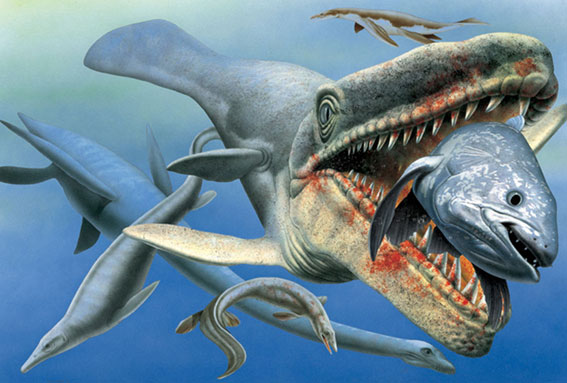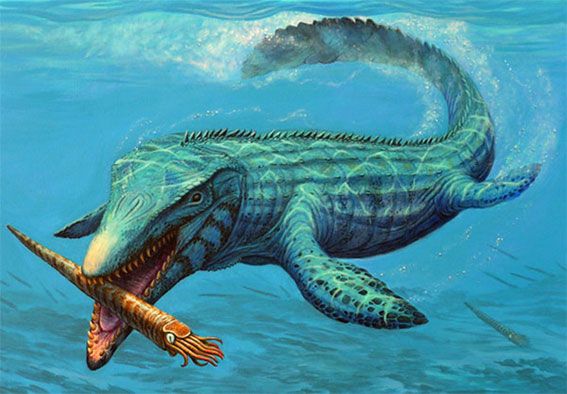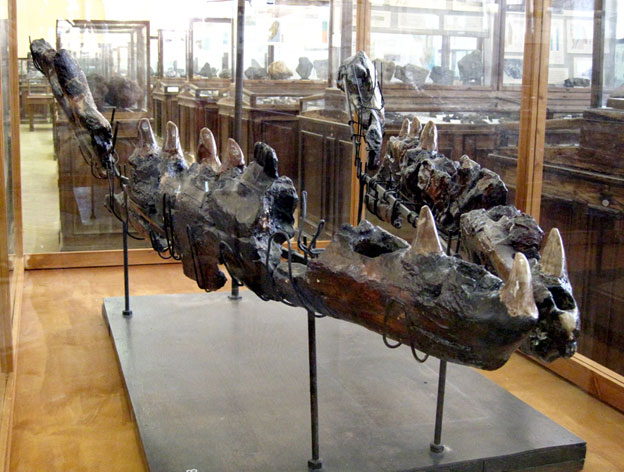MOSASAURUS, a “lizard from the Meuse River”, is a family of extinct giant marine reptiles. In structure, they were in many ways similar to modern monitor lizards, but their limbs turned into flippers.
Mosasaurs, reaching a length of 12-18 m, had an elongated head and torso, flipper-like limbs, and a long, laterally compressed tail. Their powerful jaws were set with large, inwardly curved, dagger-shaped teeth, adapted not for chewing, but only for capturing the victim. The structure of the lower jaw made it possible to swallow large prey. Their food was fish, swimming and flying lizards, molluscs; finds of sea turtles shells with traces of mosasaurus teeth are also known. They were excellent swimmers: the driving force was created by the wave-like movements of the tail, and the shape of the flippers allowed them to be used to turn a massive body in the water.

Reconstructions of the appearance of the mosasaurus
The bones of mosasaurs often bear traces of overgrown fractures, the results of fights with their own kind. The fact that many mosasaurs still survived after the jaw fractures indicates the rapid healing of wounds, which is also characteristic of modern crocodiles.
The eyes of mosasaurs were directed sideways, and they most likely lacked binocular vision. The sense of smell was also poorly developed. They lived, apparently, in shallow (up to 40-50 m) coastal waters.
Mosasaurs existed for only 25 million years and died out at the end of the Cretaceous (65 Ma).

Reconstructions of the appearance of the mosasaurus
For the first time, the jaw of a mosasaurus was discovered in 1766 near the city of Maastricht and is still kept in the Teyler Museum in Haarlem (Holland). The animal was unofficially called the “Maastricht Monster”.
The second find (a skull) was made in 1780 in the quarries of Petersberg in the vicinity of Maastricht by K. Hoffmann. However, the court decided to return the find to the owner of the quarry, Canon Godin.
In 1795, the French army invaded Holland. During the siege of Maastricht, soldiers were ordered to spare the canon's house in order to preserve the Mosasaurus skull. The canon hid the precious find, but Deputy Freysin found out about this and promised 600 bottles of wine for the skull. And the next day, 12 grenadiers triumphantly delivered the bones to him and received the promised reward. The skull was taken to Paris to the Jardin des Plantes museum.

Engraving depicting the “Maastricht Monster”
Scientists of that era, studying the found remains, suggested that they belonged to a crocodile (K. Hoffmann) or a fossil sperm whale (P. Camper). But at the end of the XVIII century, Camper's son, Adrian, in correspondence with the famous French paleontologist Georges Cuvier, expressed the opinion that the animal is similar to monitor lizards. J. Cuvier agreed with him and subsequently published a description of this giant lizard called Mosasaurus hoffmanni.
The “Maastricht monster” turned out to be the largest of the found mosasaurs (18 m), and the “Penza lizard” reached a length of 10 m.
In 1927, the Penza local historian M.A. Vedenyapin noticed a lot of bone fragments in one of the ravines. Having excavated the layer, he realized that a whole skeleton of some giant lizard could lie here. Vedenyapin decided to conduct excavations on his own, for which the city authorities issued 500 roubles from City Improvement Funds. Soon all of Penza knew about the find: crowds of curious people came to the ravine, and several bones were lost. A police squad was allocated to protect the excavation site. The lower jaw and several individual bones were recovered from the sand. The remains were poorly preserved: they were taken along with the rock, and already in the laboratory, each piece was impregnated with carpentry glue. In the autumn, the excavations had to be stopped, and the following year, money for clearing was no longer available, and the rest of the skeleton remained lying in the ravine.
Given the value of the find, the regional museum agreed to transfer it to the Geological Committee of Russia, and a plaster cast of this jaw remained in the Penza Museum of Local Lore.

Mounting the lower jaw of the “Penza Mosasaurus” in the Museum of the Geological Committee
In the accompanying note, the Penza geologist A.A. Shtukenberg wrote: “The remains of a mosasaurus are found in sandy-clay rock used by the population in the construction of furnaces. The first find of eleven vertebrae was made ... when digging a cellar in 1918. Then in 1925, a part ... of the lower jaw, two parietal bones, a square bone, and a few teeth ... were found. The finds would be more frequent if the bones resisted the shovel; they are so soft that the worker does not notice them when excavating clay ... ".

The lower jaw of a mosasaurus in the exposition of the TsNIGR Museum